Critical Exploits. Interrogating Infrastructure
Posted in: Uncategorized

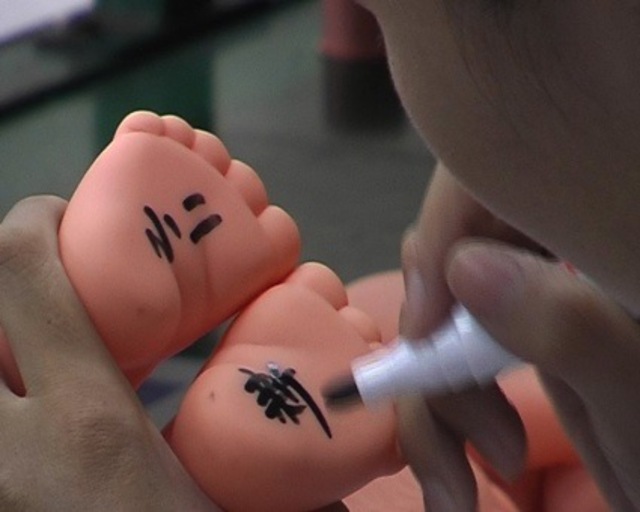
Some of his projects involved outsourcing the production of a written constitution for the UK to China and having 1,000 dolls voice it, using the price of an African financial index to control lightning in a Berlin art center, testing certain hypotheses about social behaviour in a dinner party. And building an outdoors spiral staircase for cats. continue

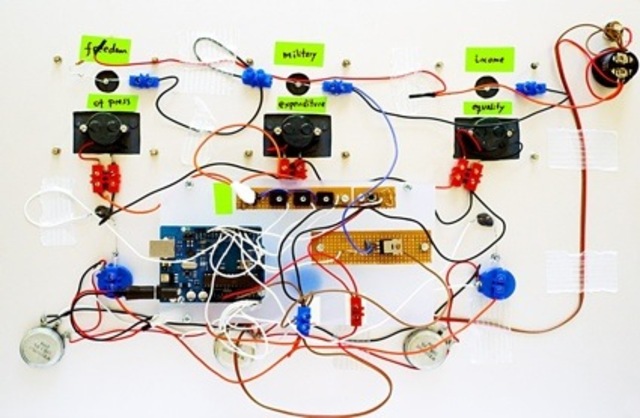
What to expect in 2012.
by
Michael Hardt and Antonio Negri
From Adbusters #99: The Big Ideas of 2012

You are missing some Flash content that should appear here! Perhaps your browser cannot display it, or maybe it did not initialize correctly.
Some of the most inspiring social struggles of 2011 have placed democracy at the top of the agenda.
Although they emerge from very different conditions, these movements – from the insurrections of the Arab Spring to the union battles in Wisconsin, from the student protests in Chile to those in the US and Europe, from the UK riots to the occupations of the Spanish indignados and the Greeks in Syntagma Square, and from Occupy Wall Street to the innumerable local forms of refusal across the world – share, first of all, a negative demand: Enough with the structures of neoliberalism! This common cry is not only an economic protest but also immediately a political one, against the false claims of representation. Neither Mubarak and Ben Ali nor Wall Street bankers, neither media elites nor even presidents, governors, members of parliament, and other elected officials – none of them represent us. The extraordinary force of refusal is very important, of course, but we should be careful not to lose track in the din of the demonstrations and conflicts of a central element that goes beyond protest and resistance. These movements also share the aspiration for a new kind of democracy, expressed in tentative and uncertain voices in some cases but explicitly and forcefully in others. The development of this aspiration is one of the threads we are most anxious to follow in 2012.
One source of antagonism that all of these movements will have to confront, even those that have just toppled dictators, is the insufficiency of modern democratic constitutions, particularly their regimes of labor, property, and representation. In these constitutions, first of all, waged labor is key to having access to income and the basic rights of citizenship, a relationship that has long functioned poorly for those outside the regular labor market, including the poor, the unemployed, unwaged female workers, immigrants, and others, but today all forms of labor are ever more precarious and insecure. Labor continues to be the source of wealth in capitalist society, of course, but increasingly outside the relationship with capital and often outside the stable wage relation. As a result, our social constitution continues to require waged labor for full rights and access in a society where such labor is less and less available.
Private property is a second fundamental pillar of the democratic constitutions, and social movements today contest not only national and global regimes of neoliberal governance but also the rule of property more generally. Property not only maintains social divisions and hierarchies but also generates some of the most powerful bonds (often perverse connections) that we share with each other and our societies. And yet contemporary social and economic production has an increasingly common character, which defies and exceeds the bounds of property. Capital’s ability to generate profit is declining since it is losing its entrepreneurial capacity and its power to administer social discipline and cooperation. Instead capital increasingly accumulates wealth primarily via forms of rent, most often organized through financial instruments, through which it captures value that is produced socially and relatively independent of its power. But every instance of private accumulation reduces the power and productivity of the common. Private property is thus becoming ever more not only a parasite but also an obstacle to social production and social welfare.
Finally, a third pillar of democratic constitutions, and object of increasing antagonism, as we said earlier, rests on the systems of representation and their false claims to establish democratic governance. Putting an end to the power of professional political representatives is one of the few slogans from the socialist tradition that we can affirm wholeheartedly in our contemporary condition. Professional politicians, along with corporate leaders and the media elite, operate only the weakest sort of representative function. The problem is not so much that politicians are corrupt (although in many cases this is also true) but rather that the constitutional structure isolates the mechanisms of political decision-making from the powers and desires of the multitude. Any real process of democratization in our societies has to attack the lack of representation and the false pretenses of representation at the core of the constitution.
Recognizing the rationality and necessity of revolt along these three axes and many others, which animate many struggles today, is, however, really only the first step, the point of departure. The heat of indignation and the spontaneity of revolt have to be organized in order to last over time and to construct new forms of life, alternative social formations.
The secrets to this next step are as rare as they are precious.
On the economic terrain we need to discover new social technologies for freely producing in common and for equitably distributing shared wealth. How can our productive energies and desires be engaged and increased in an economy not founded on private property? How can welfare and basic social resources be provided to all in a social structure not regulated and dominated by state property? We must construct the relations of production and exchange as well as the structures of social welfare that are composed of and adequate to the common.
The challenges on the political terrain are equally thorny. Some of the most inspiring and innovative events and revolts in the last decade have radicalized democratic thinking and practice by occupying and organizing a space, such as a public square, with open, participatory structures or assemblies, maintaining these new democratic forms for weeks or months. Indeed the internal organization of the movements themselves has been constantly subjected to processes of democratization, striving to create horizontal participatory network structures. The revolts against the dominant political system, its professional politicians, and its illegitimate structures of representation are thus not aimed at restoring some imagined legitimate representational system of the past but rather at experimenting with new democratic forms of expression: democracia real ya. How can we transform indignation and rebellion into a lasting constituent process? How can experiments in democracy become a constituent power, not only democratizing a public square or a neighborhood but also inventing an alternative society that is really democratic?
To confront these issues, we, along with many others, have proposed possible initial steps, such as establishing a guaranteed income, the right to global citizenship, and a process of the democratic reappropriation of the common. But we are under no illusion that we have all the answers. Instead we are encouraged by the fact that we are not alone asking the questions. We are confident, in fact, that those who are dissatisfied with the life offered by our contemporary neoliberal society, indignant about its injustices, rebellious against its powers of command and exploitation, and yearning for an alternative democratic form of life based on the common wealth we share – they, by posing these questions and pursuing their desires, will invent new solutions we cannot yet even imagine. Those are some of our best wishes for 2012.
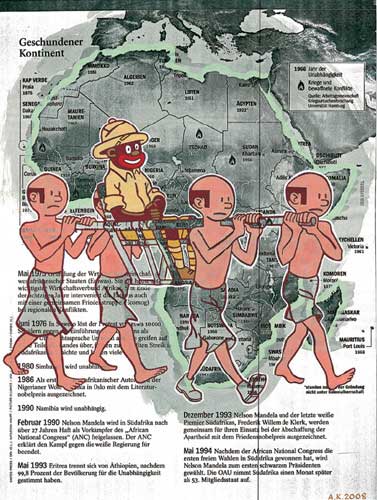
White Nightmare (Sedan Chair), 2008
Yesterday i arrived in Manhattan just on time to see the last hour of Anton Kannemeyer’s solo exhibition at Jack Shainman Gallery. The title, The Haunt of Fears, comes from the 1950s EC Comics title, The Haunt of Fear, a bi-monthly horror comic from the ’50s. As co-editor of Bitterkomix, the satirical comic magazine he started with Conrad Botes in 1992, Kannemeyer became known for creating a new South African brand unconcerned with hypocrisy and political correctness.
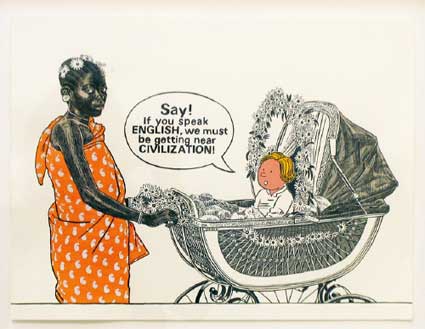
Say! If You Speak English…, 2008
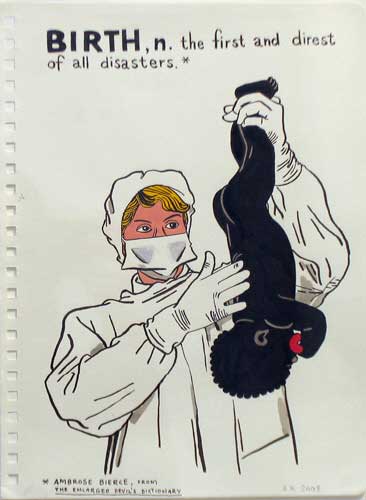
Birth, 2008
The gallery presented a selection of Kannemeyer’s works on paper from The Alphabet of Democracy-series, a new series entitled Cursed Paradise and drawings from recent sketch books; all of which raise extremely uncomfortable questions in the debate about racial stereotypes and South Africa cultural and socio-political landscape.
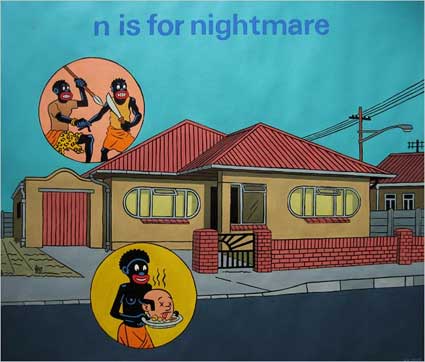
“n is for nightmare” (2008)
With The Alphabet of Democracy, the white South African artist tackles many issues politicians and journalists tent to “diplomatically” avoid. The series sharply comments on the madness below the surface of the rabidly conformist parts of white South African society, especially the Afrikaans community. Black politicians are not protected from his sarcasm either as the alphabet also targets the absurdity of some of their statements. However, some images from this series transcend satire. J is for Jack Russell, for example, shows a dog sleeping on the blanket with which its master’s murdered body has been covered.
In this context, the word “democracy” becomes subversive. The liberated South African society and its form of government are shown as just another arbitrary social order fraught with moral ambiguity and human absurdity.
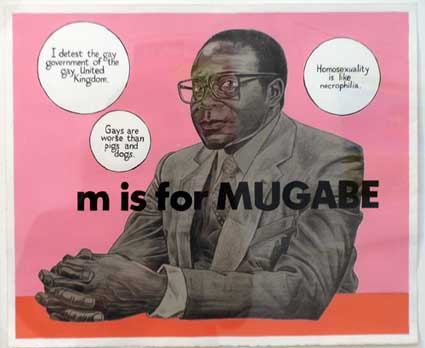
M is for Mugabe
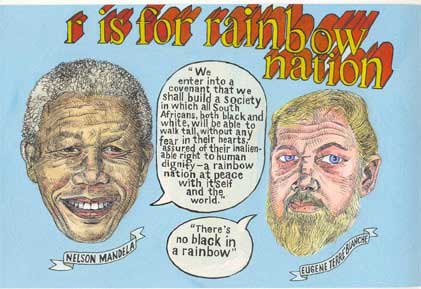
R is for Rainbow nation
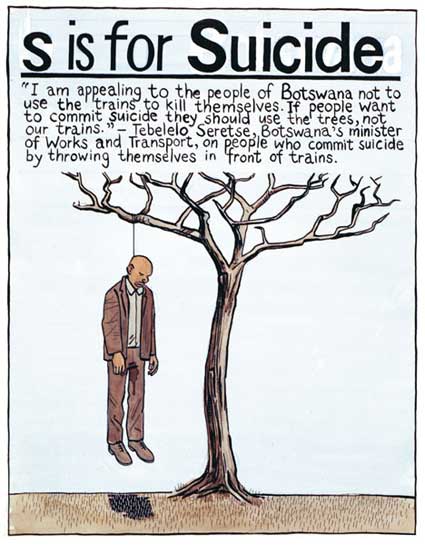
S is for suicide
In Pappa in Afrika, a parody of the controversial Tintin in the Congo, as a white African trapped in his own incriminating skin – a character who cannot escape his colonial past regardless of his personal political convictions. It depicts a content white man in a car driven by a black servant. A machine-gun-toting black soldier stands guard, while poor black natives watch the car filled with boxes labeled Texaco and Halliburton pass.

White Nightmare: Black Dicks
More images: Michael Stevenson and Jack Shainman Gallery.